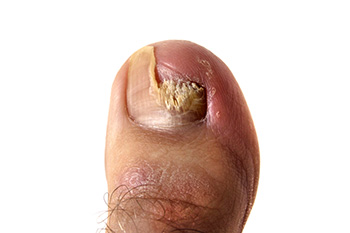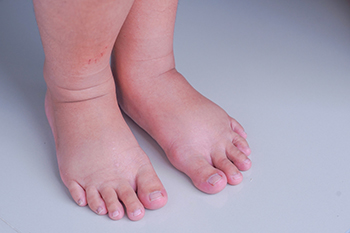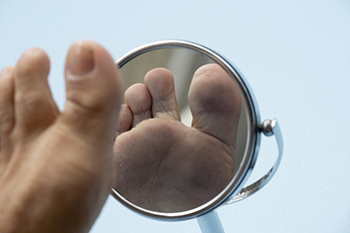Richfield (435) 896-6497
Ephraim (435) 283-4076
July 2024
Understanding Toenail Fungus
 Toenail fungus, medically known as onychomycosis, is a common infection affecting the nails. It is caused by fungi, such as dermatophytes, which thrive in warm, moist environments. Symptoms include thickened, discolored nails that may become brittle or crumbly. The infection often starts as a white or yellow spot under the nail and can spread, leading to nail distortion and possible separation from the nail bed. Causes include frequent exposure to damp conditions, such as sweaty shoes or communal showers. Risk factors include older age, a history of athlete's foot, weakened immune systems, and poor circulation. Preventative measures include keeping feet dry, wearing breathable footwear, and avoiding walking barefoot in public areas. If you have developed toenail fungus, it is suggested that you consult a podiatrist who can offer you effective treatment solutions, which often include prescribed medication.
Toenail fungus, medically known as onychomycosis, is a common infection affecting the nails. It is caused by fungi, such as dermatophytes, which thrive in warm, moist environments. Symptoms include thickened, discolored nails that may become brittle or crumbly. The infection often starts as a white or yellow spot under the nail and can spread, leading to nail distortion and possible separation from the nail bed. Causes include frequent exposure to damp conditions, such as sweaty shoes or communal showers. Risk factors include older age, a history of athlete's foot, weakened immune systems, and poor circulation. Preventative measures include keeping feet dry, wearing breathable footwear, and avoiding walking barefoot in public areas. If you have developed toenail fungus, it is suggested that you consult a podiatrist who can offer you effective treatment solutions, which often include prescribed medication.
For more information about treatment, contact Dr. Blake Zobell of Utah. Our doctor can provide the care you need to keep you pain-free and on your feet.
Toenail Fungus Treatment
Toenail fungus is a condition that affects many people and can be especially hard to get rid of. Fortunately, there are several methods to go about treating and avoiding it.
Antifungals & Deterrence
Oral antifungal medicine has been shown to be effective in many cases. It is important to consult with a podiatrist to determine the proper regiment for you, or potentially explore other options.
Applying foot powder on the feet and shoes helps keep the feet free of moisture and sweat.
Sandals or open toed shoes – Wearing these will allow air movement and help keep feet dry. They also expose your feet to light, which fungus cannot tolerate. Socks with moisture wicking material also help as well.
If you have any questions please feel free to contact one of our offices located in Richfield and Ephraim, Utah . We offer the newest diagnostic tools and technology to treat your foot and ankle needs.
Poor Circulation in Your Feet
 Are your feet frequently cold or numb? If so, you may be experiencing poor circulation, a condition that affects blood flow to the feet. Poor circulation can lead to a range of uncomfortable symptoms, including cold feet, numbness, tingling sensations, and sometimes slowly healing wounds. This condition is often caused by underlying health issues such as diabetes, peripheral artery disease, or vascular problems. Ignoring poor circulation can lead to serious complications, including tissue damage and infections. Don't let poor circulation hold you back from enjoying life. If you are experiencing poor circulation in your feet, it is suggested that you schedule an appointment with a podiatrist to discuss treatment options and prevent any further complications or discomfort.
Are your feet frequently cold or numb? If so, you may be experiencing poor circulation, a condition that affects blood flow to the feet. Poor circulation can lead to a range of uncomfortable symptoms, including cold feet, numbness, tingling sensations, and sometimes slowly healing wounds. This condition is often caused by underlying health issues such as diabetes, peripheral artery disease, or vascular problems. Ignoring poor circulation can lead to serious complications, including tissue damage and infections. Don't let poor circulation hold you back from enjoying life. If you are experiencing poor circulation in your feet, it is suggested that you schedule an appointment with a podiatrist to discuss treatment options and prevent any further complications or discomfort.
While poor circulation itself isn’t a condition; it is a symptom of another underlying health condition you may have. If you have any concerns with poor circulation in your feet contact Dr. Blake Zobell of Utah. Our doctor will treat your foot and ankle needs.
Poor Circulation in the Feet
Peripheral artery disease (PAD) can potentially lead to poor circulation in the lower extremities. PAD is a condition that causes the blood vessels and arteries to narrow. In a linked condition called atherosclerosis, the arteries stiffen up due to a buildup of plaque in the arteries and blood vessels. These two conditions can cause a decrease in the amount of blood that flows to your extremities, therefore resulting in pain.
Symptoms
Some of the most common symptoms of poor circulation are:
- Numbness
- Tingling
- Throbbing or stinging pain in limbs
- Pain
- Muscle Cramps
Treatment for poor circulation often depends on the underlying condition that causes it. Methods for treatment may include insulin for diabetes, special exercise programs, surgery for varicose veins, or compression socks for swollen legs.
As always, see a podiatrist as he or she will assist in finding a regimen that suits you. A podiatrist can also prescribe you any needed medication.
If you have any questions, please feel free to contact one of our offices located in Richfield and Ephraim, Utah . We offer the newest diagnostic and treatment technologies for all your foot care needs.
Causes of Swollen Feet and Ankles

Swelling in the feet and ankles can signal underlying health issues that may need attention. Edema, or fluid buildup, is a common cause of swelling, particularly in older individuals. Gravity contributes to this condition, making the lower body areas more prone to noticeable swelling. Causes of foot swelling include excessive weight, blood clots, infections, and venous insufficiency. Among other causes are injuries, surgeries, and certain medications like antidepressants, blood pressure drugs, hormones, and steroids. Lifestyle factors, such as long flights, as well as prolonged standing and hormonal changes during pregnancy can also trigger swelling. Some cases of edema can be managed with leg elevation, exercise, a low-salt diet, and wearing support stockings. However, it's extremely important to seek medical attention if swelling is severe, accompanies shortness of breath or chest pain, or doesn't improve with self-care measures. If you're experiencing persistent swelling in the feet or ankles, it is suggested that you make an appointment with a podiatrist for an exam. This foot doctor will conduct a thorough exam and may recommend diagnostic tests to determine the underlying cause.
Swollen feet can be a sign of an underlying condition. If you have any concerns, contact Dr. Blake Zobell of Utah. Our doctor can provide the care you need to keep you pain-free and on your feet.
Swollen feet are a common ailment among pregnant women and people who stand or sit for extended periods. Aging may increase the possibility of swollen feet and patients who are obese often notice when their feet are swelling too. There may be medical reasons why swollen feet occur:
- Phlebitis - A condition that causes the veins to become inflamed and can also cause leg pain.
- Liver disease - This may lead to low blood levels of albumin which is a protein. This can cause fluid in the blood to pass into the tissues and several areas of the body can become swollen.
- Heart failure - When the heart doesn’t pump properly the blood that is normally pumped back to the heart can pool in the veins of the legs causing swollen feet.
- Kidney disease - One of the main functions of the kidneys is releasing excess fluid in the body. This type of condition can make it difficult for the kidneys to function properly, and as a result the feet may become swollen.
- Deep-vein thrombosis (DVT)- This is a serious condition where blood clots form in the veins of the legs. They can block the return of blood from the legs to the heart which may cause the feet to swell. It is important to be treated by a podiatrist if this condition is present.
Swollen feet can also be caused by bone and tendon conditions, including fractures, arthritis, and tendinitis. Additionally, there may be skin and toenail conditions and an infection may cause the feet to swell. Patients who take medicine to treat high blood pressure may be prone to getting swollen feet.
Many patients elevate their feet to help relieve the swelling and this is generally a temporary remedy. When a podiatrist is consulted the reason behind the swelling can be uncovered and subsequently treated.
If you have any questions please feel free to contact one of our offices located in Richfield and Ephraim, Utah . We offer the newest diagnostic tools and technology to treat your foot and ankle needs.
Are Bunions Affecting Your Everyday Life?
Recognizing Signs of Diabetes in the Foot

Diabetes can manifest in the feet through several noticeable signs. One common symptom is persistent numbness or tingling, often caused by nerve damage, known as diabetic neuropathy. This condition can lead to a loss of sensation, making it difficult to detect injuries or infections. Another sign is slow-healing sores or ulcers, which can develop from minor cuts or blisters due to poor circulation. Discoloration of the skin, such as redness, can indicate inflammation or infection. Swelling in the feet and ankles might also be present, signaling potential underlying issues. Additionally, changes in skin texture, including dryness or cracking, can occur. Fungal infections, particularly between the toes, are more frequent in diabetics. If you have diabetes, it is strongly suggested that you are under the care of a podiatrist who can help you manage this serious condition.
Diabetic foot care is important in preventing foot ailments such as ulcers. If you are suffering from diabetes or have any other concerns about your feet, contact Dr. Blake Zobell from Utah. Our doctor can provide the care you need to keep you pain-free and on your feet.
Diabetic Foot Care
Diabetes affects millions of people every year. The condition can damage blood vessels in many parts of the body, especially the feet. Because of this, taking care of your feet is essential if you have diabetes, and having a podiatrist help monitor your foot health is highly recommended.
The Importance of Caring for Your Feet
- Routinely inspect your feet for bruises or sores.
- Wear socks that fit your feet comfortably.
- Wear comfortable shoes that provide adequate support.
Patients with diabetes should have their doctor monitor their blood levels, as blood sugar levels play such a huge role in diabetic care. Monitoring these levels on a regular basis is highly advised.
It is always best to inform your healthcare professional of any concerns you may have regarding your feet, especially for diabetic patients. Early treatment and routine foot examinations are keys to maintaining proper health, especially because severe complications can arise if proper treatment is not applied.
If you have any questions please feel free to contact one of our offices located in Richfield and Ephraim, Utah . We offer the newest diagnostic and treatment technologies for all your foot and ankle needs.
Different Types of Open Foot Wounds
 Open wounds on the feet are injuries that break the skin's surface, leaving underlying tissue exposed. Each type of open wound has distinct signs and characteristics. Abrasions, commonly referred to as scrapes, occur when skin on the foot experiences superficial damage from rubbing against a rough surface. Lacerations are cuts caused by sharp objects, which may vary in depth and severity depending on the force of the injury. Puncture wounds in the foot occur when a sharp object penetrates the skin, creating a small hole that can lead to deep tissue damage and infection if not properly treated. Avulsions, which often result from traumatic injuries in feet, involve the tearing away of skin and tissue from the body. Surgical wounds are intentional incisions made during surgical procedures. These open-foot wounds require careful monitoring and care to prevent complications during and after the procedure. Diabetic ulcers are open wounds often found on the feet of diabetics, resulting from poor circulation and nerve damage. Regardless of the type, appropriate wound care can decrease risk of infection in the foot and promote healing. If you're experiencing challenges with open wounds, it's suggested to consult with a podiatrist for effective treatment and management, reducing complications and supporting a successful recovery.
Open wounds on the feet are injuries that break the skin's surface, leaving underlying tissue exposed. Each type of open wound has distinct signs and characteristics. Abrasions, commonly referred to as scrapes, occur when skin on the foot experiences superficial damage from rubbing against a rough surface. Lacerations are cuts caused by sharp objects, which may vary in depth and severity depending on the force of the injury. Puncture wounds in the foot occur when a sharp object penetrates the skin, creating a small hole that can lead to deep tissue damage and infection if not properly treated. Avulsions, which often result from traumatic injuries in feet, involve the tearing away of skin and tissue from the body. Surgical wounds are intentional incisions made during surgical procedures. These open-foot wounds require careful monitoring and care to prevent complications during and after the procedure. Diabetic ulcers are open wounds often found on the feet of diabetics, resulting from poor circulation and nerve damage. Regardless of the type, appropriate wound care can decrease risk of infection in the foot and promote healing. If you're experiencing challenges with open wounds, it's suggested to consult with a podiatrist for effective treatment and management, reducing complications and supporting a successful recovery.
Wound care is an important part in dealing with diabetes. If you have diabetes and a foot wound or would like more information about wound care for diabetics, consult with Dr. Blake Zobell from Utah. Our doctor will assess your condition and provide you with quality foot and ankle treatment.
What Is Wound Care?
Wound care is the practice of taking proper care of a wound. This can range from the smallest to the largest of wounds. While everyone can benefit from proper wound care, it is much more important for diabetics. Diabetics often suffer from poor blood circulation which causes wounds to heal much slower than they would in a non-diabetic.
What Is the Importance of Wound Care?
While it may not seem apparent with small ulcers on the foot, for diabetics, any size ulcer can become infected. Diabetics often also suffer from neuropathy, or nerve loss. This means they might not even feel when they have an ulcer on their foot. If the wound becomes severely infected, amputation may be necessary. Therefore, it is of the upmost importance to properly care for any and all foot wounds.
How to Care for Wounds
The best way to care for foot wounds is to prevent them. For diabetics, this means daily inspections of the feet for any signs of abnormalities or ulcers. It is also recommended to see a podiatrist several times a year for a foot inspection. If you do have an ulcer, run the wound under water to clear dirt from the wound; then apply antibiotic ointment to the wound and cover with a bandage. Bandages should be changed daily and keeping pressure off the wound is smart. It is advised to see a podiatrist, who can keep an eye on it.
If you have any questions, please feel free to contact one of our offices located in Richfield and Ephraim, Utah . We offer the newest diagnostic and treatment technologies for all your foot care needs.









